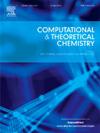First-principles calculations to investigate the oxygen deficiency effect on optoelectronic and mechano-thermoelectric properties of BaTiO3-δ (δ = 0, 0.5, 1)
IF 3
3区 化学
Q3 CHEMISTRY, PHYSICAL
引用次数: 0
Abstract
In our study of cubic perovskite materials, we employed the plane wave full-potential linearized augmented plane wave (FP-LAPW) method, grounded in density functional theory (DFT), as implemented in the WIEN2k software package, to determine the crystallographic, electronic, and optical properties of ( = 0, 0.5, 1) compounds. Various GGA methods treat the potential for exchange and correlation. Barium titanate is well-known for its interesting electronic properties, particularly its ferroelectric behavior. The oxygen deficiency in this material changes their electronic behavior BaTiO3, BaTiO2.5, and BaTiO2 are promising materials for optical applications in the visible and UV spectra. Furthermore, as oxygen deficiency increases, hole mobility increases as well, enhancing both the optical and electrical conductivities. BaTiO₃ exhibits typical insulating behavior with a well-defined band gap equal to 1.84 eV by GGA method. BaTiO2.5 shows characteristics of a semiconductor or a narrow-gap insulator equal to 0.37 eV by GGA method, with an increased density of states near the Fermi level, and BaTiO2 displays metallic behavior. Finally, based on the results obtained using both methods, it can be concluded that the band gap energy is inversely proportional to the oxygen vacancy concentration.

第一性原理计算研究缺氧对BaTiO3-δ (δ = 0,0.5, 1)光电和机械热电性能的影响
在我们对立方钙钛矿材料的研究中,我们采用了基于密度泛函理论(DFT)的平面波全势线性化增强平面波(FP-LAPW)方法,并在WIEN2k软件包中实现,以确定BaTiO3−δ (δ = 0,0.5, 1)化合物的晶体学,电子和光学性质。各种GGA方法处理交换和相关的潜力。钛酸钡BaTiO3以其有趣的电子特性,特别是其铁电性而闻名。BaTiO3、BaTiO2.5和BaTiO2在可见光和紫外光谱中都是很有前途的光学材料。此外,随着氧缺乏的增加,空穴迁移率也会增加,从而提高了光学和电导率。通过GGA方法,BaTiO₃具有典型的绝缘性能,其带隙为1.84 eV。通过GGA方法,BaTiO2.5表现出半导体或0.37 eV窄间隙绝缘体的特性,在费米能级附近态密度增加,batioo2表现出金属行为。最后,根据两种方法得到的结果,可以得出带隙能量与氧空位浓度成反比的结论。
本文章由计算机程序翻译,如有差异,请以英文原文为准。
求助全文
约1分钟内获得全文
求助全文
来源期刊

Computational and Theoretical Chemistry
CHEMISTRY, PHYSICAL-
CiteScore
4.20
自引率
10.70%
发文量
331
审稿时长
31 days
期刊介绍:
Computational and Theoretical Chemistry publishes high quality, original reports of significance in computational and theoretical chemistry including those that deal with problems of structure, properties, energetics, weak interactions, reaction mechanisms, catalysis, and reaction rates involving atoms, molecules, clusters, surfaces, and bulk matter.
 求助内容:
求助内容: 应助结果提醒方式:
应助结果提醒方式:


